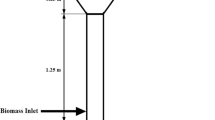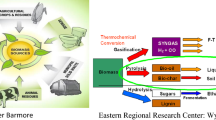Abstract
The combustion characteristics and kinetics of oily sludge (OS), biomass (wheat straw, WS), and their mixtures in the different blending ratios were investigated in the air (O2/N2) and oxy-fuel (O2/CO2) atmospheres using a thermogravimetric analyzer (TGA). Results show that replacement of N2 by CO2 with the identical oxygen concentration decreases the reaction rate of OS and WS, and the two main combustion processes including release and combustion of volatile matters and fixed carbon combustion finish at a lower level reaction. A higher oxygen concentration in the oxy-fuel combustion reduces the differences of the air and oxy-fuel combustion parameters. Compared with an O2/N2 atmosphere, a higher oxygen concentration in an O2/CO2 atmosphere increases ignition temperature and decreases burnout temperature. The adding percentages of WS into OS and the oxygen concentrations in the oxy-fuel atmosphere have the significant effects on reaction heat and kinetic parameters of OS combustion. This work improves the understanding and development of OS oxy-fuel combustion with biomass.






Similar content being viewed by others
References
Hu G, Li J, Zeng G (2013) Recent development in the treatment of oily sludge from petroleum industry: a review. J Hazard Mater 261:470–490
Da Silva LJ, Alves FC, de França FP (2012) A review of the technological solutions for the treatment of oily sludges from petroleum refineries. Waste Manag Res 30(10):1016–1030
Werle S, Wilk RK (2010) A review of methods for the thermal utilization of sewage sludge: the polish perspective. Renew Energy 35(9):1914–1919
Singh D, Croiset E, Douglas PL, Douglas MA (2003) Techno-economic study of CO2 capture from an existing coal-fired power plant: MEA scrubbing vs. O2/CO2 recycle combustion. Energy Convers Manag 44(19):3073–3091
Chen C, Zhao C, Liang C, Pang K (2007) Calcination and sintering characteristics of limestone under O2/CO2 combustion atmosphere. Fuel Process Technol 88(2):171–178
Abbasi-Atibeh E, Yozgatligil A (2014) A study on the effects of catalysts on pyrolysis and combustion characteristics of Turkish lignite in oxy-fuel conditions. Fuel 115:841–849
Yin C, Yan J (2016) Oxy-fuel combustion of pulverized fuels: combustion fundamentals and modeling. Appl Energy 162:742–762
Demirbas A (2004) Combustion characteristics of different biomass fuels. Prog Energy Combust Sci 30(2):219–230
Sher F, Pans MA, Afilaka DT, Sun C, Liu H (2017) Experimental investigation of woody and non-woody biomass combustion in a bubbling fluidised bed combustor focusing on gaseous emissions and temperature profiles. Energy 141:2069–2080
Hai IU, Sher F, Zarren G, Liu H (2019) Experimental investigation of tar arresting techniques and their evaluation for product syngas cleaning from bubbling fluidized bed gasifier. J Clean Prod 240:118239
Hai IU, Sher F, Yaqoob A, Liu H (2019) Assessment of biomass energy potential for SRC willow woodchips in a pilot scale bubbling fluidized bed gasifier. Fuel 258:116143
Sher F, Iqbal SZ, Liu H, Imran M, Snape CE (2020) Thermal and kinetic analysis of diverse biomass fuels under different reaction environment: a way forward to renewable energy sources. Energy Convers Manag 203:112266
Bolognesi S, Bernardi G, Callegari A, Dondi D, Capodaglio AG (2019) Biochar production from sewage sludge and microalgae mixtures: properties, sustainability and possible role in circular economy. Biomass Convers Biorefinery 2019:1–11
Magdziarz A, Wilk M (2013) Thermogravimetric study of biomass, sewage sludge and coal combustion. Energy Convers Manag 75:425–430
Zhou X, Jia H, Qu C, Fan D, Wang C (2017) Low-temperature co-pyrolysis behaviours and kinetics of oily sludge: effect of agricultural biomass. Environ Technol 38(3):361–369
Huang L, Liu J, He Y, Sun S, Chen J, Sun J, Chang K, Kuo J, Ning X (2016) Thermodynamics and kinetics parameters of co-combustion between sewage sludge and water hyacinth in CO2/O2 atmosphere as biomass to solid biofuel. Bioresour Technol 218:631–642
Deng S, Wang X, Tan H, Mikulčić H, Yang F, Li Z, Duić N (2016) Thermogravimetric study on the co-combustion characteristics of oily sludge with plant biomass. Thermochim Acta 633:69–76
Obi OF, Okongwu KC (2016) Characterization of fuel briquettes made from a blend of rice husk and palm oil mill sludge. Biomass Convers Biorefinery 6(4):449–456
Yuzbasi NS, Selçuk N (2011) Air and oxy-fuel combustion characteristics of biomass/lignite blends in TGA-FTIR. Fuel Process Technol 92(5):1101–1108
Li Q, Zhao C, Chen X, Wu W, Li Y (2009) Comparison of pulverized coal combustion in air and in O2/CO2 mixtures by thermo-gravimetric analysis. J Anal Appl Pyrolysis 85(1):521–528
López R, Fernández C, Fierro J, Cara J, Martínez O, Sánchez ME (2014) Oxy-combustion of corn, sunflower, rape and microalgae bioresidues and their blends from the perspective of thermogravimetric analysis. Energy 74:845–854
Liu X, Chen M, Yu D (2013) Oxygen enriched co-combustion characteristics of herbaceous biomass and bituminous coal. Thermochim Acta 569:17–24
Yuzbasi NS, Selçuk N (2012) Air and oxy-fuel combustion behaviour of petcoke/lignite blends. Fuel 92(1):137–144
Deng S, Wang X, Tan H, Mikulčić H, Li Z, Cao R, Wang Z, Vujanović M (2015) Experimental and modeling study of the long cylindrical oily sludge drying process. Appl Therm Eng 91:354–362
Wang X, Deng S, Tan H, Adeosun A, Vujanović M, Yang F, Duić N (2016) Synergetic effect of sewage sludge and biomass co-pyrolysis: a combined study in thermogravimetric analyzer and a fixed bed reactor. Energy Convers Manag 118:399–405
Lu Y, Wang Y, Zhang J, Xu Y, Li G, Zhang Y (2019) Investigation on the catalytic effect of AAEMs in Zhundong coal on the combustion characteristics of Changji oil shale and its kinetics. Energy 178:89–100
Parshetti GK, Quek A, Betha R, Balasubramanian R (2014) TGA–FTIR investigation of co-combustion characteristics of blends of hydrothermally carbonized oil palm biomass (EFB) and coal. Fuel Process Technol 118:228–234
Chen J, Xie C, Liu J, He Y, Xie W, Zhang X, Chang K, Kuo J, Sun J, Zheng L, Sun S, Buyukada M, Evrendilek F (2018) Co-combustion of sewage sludge and coffee grounds under increased O2/CO2 atmospheres: thermodynamic characteristics, kinetics and artificial neural network modeling. Bioresour Technol 250:230–238
Wongsiriamnuay T, Tippayawong N (2010) Non-isothermal pyrolysis characteristics of giant sensitive plants using thermogravimetric analysis. Bioresour Technol 101(14):5638–5644
Vamvuka D, Kakaras E, Kastanaki E, Grammelis P (2003) Pyrolysis characteristics and kinetics of biomass residuals mixtures with lignite. Fuel 82(15–17):1949–1960
Zhao J, Xiuwen W, Hu J, Liu Q, Shen D, Xiao R (2014) Thermal degradation of softwood lignin and hardwood lignin by TG-FTIR and Py-GC/MS. Polym Degrad Stab 108:133–138
Brebu M, Vasile C (2010) Thermal degradation of lignin—a review, cell. Chem Technol 44(9):353–363
Wall T, Liu Y, Spero C, Elliott L, Khare S, Rathnam R, Zeenathal F, Moghtaderi B, Buhre B, Sheng C, Gupta R, Yamada T, Makino K, Yu J (2009) An overview on oxyfuel coal combustion—state of the art research and technology development. Chem Eng Res Des 87(8):1003–1016
Ahn S, Choi G, Kim D (2014) The effect of wood biomass blending with pulverized coal on combustion characteristics under oxy-fuel condition. Biomass Bioenergy 71:144–154
Fryda L, Sobrino C, Cieplik M, Van de Kamp W (2010) Study on ash deposition under oxyfuel combustion of coal/biomass blends. Fuel 89(8):1889–1902
Zhuo Z, Liu J, Sun S, Sun J, Kuo J, Chang K, Fu J, Wang Y (2017) Thermogravimetric characteristics of textile dyeing sludge, coal and their blend in N2/O2 and CO2/O2 atmospheres. Appl Therm Eng 111:87–94
Cao W, Li J, Martí-Rosselló T, Zhang X (2019) Experimental study on the ignition characteristics of cellulose, hemicellulose, lignin and their mixtures. J Energy Inst 92(5):1303–1312
Liu Z, Wang G, Li P, Li C (2019) Investigation on combustion of high-sulfur coal catalyzed with industrial waste slags. J Energy Inst 92(3):621–629
Chen J, Mu L, Cai J, Yao P, Song X, Yin H, Li A (2015) Pyrolysis and oxy-fuel combustion characteristics and kinetics of petrochemical wastewater sludge using thermogravimetric analysis. Bioresour Technol 198:115–123
Liu GH, Ma XQ, Yu Z (2009) Experimental and kinetic modeling of oxygen-enriched air combustion of municipal solid waste. Waste Manag 29(2):792–796
Chen C, Ma X, Liu K (2011) Thermogravimetric analysis of microalgae combustion under different oxygen supply concentrations. Appl Energy 88(9):3189–3196
Wei X, Schnell U, Hein KRG (2005) Behaviour of gaseous chlorine and alkali metals during biomass thermal utilization. Fuel 84(7–8):841–848
Shen B (2006) Study on MSW catalytic combustion by TGA. Energy Convers Manag 47(11–12):1429–1437
Funding
This work was supported by the National Key Research and Development Plan of China (No. 2016YFB0601504) and the China Postdoctoral Science Foundation (No. 2019 M653648).
Author information
Authors and Affiliations
Corresponding author
Additional information
Publisher’s note
Springer Nature remains neutral with regard to jurisdictional claims in published maps and institutional affiliations.
Rights and permissions
About this article
Cite this article
Deng, S., Lu, X., Tan, H. et al. Effects of a combination of biomass addition and atmosphere on combustion characteristics and kinetics of oily sludge. Biomass Conv. Bioref. 11, 393–407 (2021). https://doi.org/10.1007/s13399-020-00697-y
Received:
Revised:
Accepted:
Published:
Issue Date:
DOI: https://doi.org/10.1007/s13399-020-00697-y




